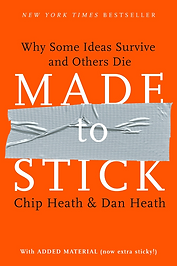
BOOK SUMMARIES

Book: Made to Stick
Author: Chip Heath & Dan Heath
Purchase: Print | eBook | Audiobook
Citation: Heath, C. & Heath, D. (2007). Made to stick : why some ideas survive and others die. New York: Random House.
Principles of Being Sticky
-
Simplicity
-
Unexpectedness
-
Concreteness
-
Credibility
-
Emotions
-
Stories
Simplicity
Should have a crisp, plain-talk statement that appears at the top of lesson/order: “If we do nothing else during tomorrow’ mission we must…."; “The single most important thing that we must do tomorrow is…”
Must find the core of the idea - strip an idea down to its most critical essence; The more we reduce the amount of info, the stickier it will be.
Only ideas with profound compactness are valuable. You need to pack a lot of meaning into a little bit of messaging. To do this you must tap the existing memory of your audience.
A great way to avoid useless information is to use analogies - analogies make it possible to understand a compact message because they invoke concepts you already know.
Unexpectedness
The first problem of communication is getting someone’s attention. The most basic way to do this is break a pattern.
Unexpected ideas are more likely to stick because surprise makes us pay attention and think. That extra attention and thinking sears unexpected events into our memories.
Concreteness
Mission statements, visions, etc. - are often ambiguous and meaningless. Sticky ideas are full of concrete images because our brains remember concrete data.
Abstraction makes it hard to understand an idea - people can interpret an abstract idea in many different ways.
Using concreteness is a basic principle of understanding - Novices crave concreteness.
Credibility
If were trying to persuade a skeptical audience to believe a new message, were fighting an uphill battle against a lifetime of personal learning and social relationships.
Telling stories using real people is the most compelling way to be credible.
The honesty and trustworthiness of our sources, not their status, allows them to act as authorities on a topic.
Statistics are rarely meaningful in and of themselves. It’s more important for people to remember the relationship than the number.
Emotions
How do we get people to care about our ideas - we need them to feel something.
If we want to make people care, we’ve got to tap into the things they care about.
WIIFY - “what’s in it for you” - should be a central aspect of every speech.
How do we get people to care? We get them to take off their analytical hats. We create empathy and show our ideas are associated with things that people already care about.
Stories
Stories have an amazing dual power to simulate and inspire. Most of the time we don’t have to use much creativity to harness these powers - we just need to be ready to spot the good stories that life generates every day.
If you’re a great spotter of stories you’ll trump a great creator - the world will always produce more great ideas than any single individual.
When students at Stanford are asked to recall speeches - 63% remember stories - only 5% remember any individual statistic.
Other Key Ideas:
Customer communication is usually taken very seriously while employee communication isn’t. This is a mistake. Employees need to understand what your organization stands for, where it’s headed, and what will make it successful.
Employees rely on leaders to define the organization's game plan. Leaders rely on employees to tell them how the game is going.
Don’t worry about repetition, repetition, repetition. Instead, focus on using stories - it’s easier to remember stories.
Strategies should be living and active - if they are to become embodied they must be woven into day-to-day conversations and decisions.
The Curse of Knowledge - once we know something, we find it hard to imagine what it was like not to know it.
To fight a sticky idea that you don’t want any more, must come up with a “stickier” idea.
